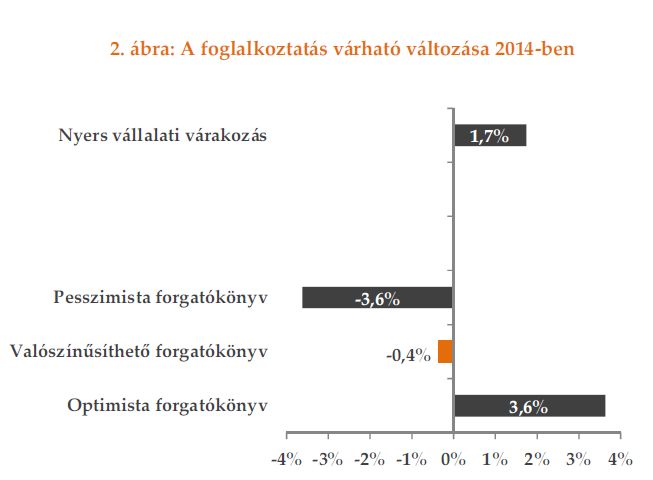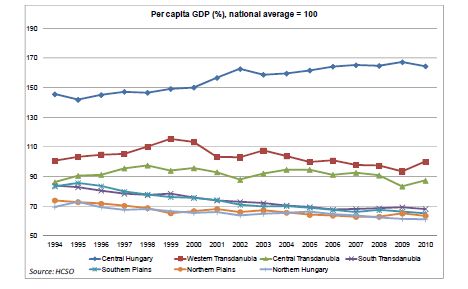- Research fields
- Further Research Areas
- Research year
- Related documents
The newest wave of the joint research project by the National Labour Office and the HCCI Institute for Economic and Enterprise Research entitled “Short-term Labour Market Forecast” took place in September and October of 2013. During the survey managers of 7,108 companies were asked about current and expected labour demand. The results can be considered as representative both geographically and by economic sector, as well as by company size. The following is a short presentation of the results compared with other data sources and relevant estimates.
After three years a positive change can be seen in the subjective business situation assessment of companies – the index increased by five percentage points in a year. In the autumn of 2013 the rate of companies that were considered to be in a favourable business situation was 16 percent points higher than those who had a negative outlook. The business outlook for 2014 is more optimistic than at any time in recent years – the index is near 24 points. This optimism can be traced back to the expectations of the companies in the services sector, those within the areas of finance, and export-oriented companies.
Read more >>>In the third quarter of 2013 the small and medium enterprises show a positive image about their current business situation. All of the indicators referring to the current situation showed an increase compared to the previous period. In contrast, the expectations for the future indicate a negative outlook, as all of the forecasting indicators fell. These opposing effects resulted a decrease of the SME Business Climate Index. The Uncertainty Index also decreased comparing to the previous period, what means that the diversity of opinions among SMEs has reduced the on the previous quarter.
On the following link an English summary of the paper can be downloaded.
Read more >>>October 2013 was the thirty-sixth occasion of the SME Outlook, a joint research project started by the HCCI Institute for Economic and Enterprise Research (IEER) together with Figyelő (the Monitor) and the Volksbank. The project examine the fiscal situation, prospects and factors affecting the financial position of companies within the Hungarian small and medium enterprise sector. In addition to questions on the business sentiment of enterprises, in each case our analysis looked into current issues and problems, and the corporate responses to these which, in turn, play an important role in this sector's adaptability, profitability and development. For the October 2013 survey 299 company managers replied to our questions over the phone.
Based on the results of the third quarter of 2013, the indicators show a positive image of the current situation of small and medium enterprises. All indicators for the current business situation showed an increase compared to the previous period. In contrast, expectations for the future indicate a negative outlook, as all such indicators fell. Altogether, these contrasting effects led the SME Business Climate Index to fall, thus the significant increase in 2013 reached a negative turning point. The Uncertainty Index decreased compared to the previous period, which represents a decline in the diversity of opinions among SMEs toward their current and expected business situations.
Read more >>>October 2013 was the thirty second instance of the HCCI Institute for Economic and Enterprise Research (IEER) business climate survey in which more than 14,000 companies are examined every year in April and October, with the assistance of regional chambers. In Hungary this is the largest study of its kind. This research is a part of the Eurochambres business climate survey, which is an approximately 14 million enterprise-wide study of European business. In October this year 3,514 companies filled out our questionnaire.
The IEER Business Climate Index rose almost 10 points to +23 points from April's +14 points. This represents a medium-high value; the last time a similar level was reached was in 2010. The value of the Uncertainty Index is also very high at a 55-point level. The latter suggests that within the business community readings of positive trends for the year are still not quite clear or uniform. For many firms the business situation has not improved, and their expectations are not positive. Meanwhile, the available data for the current performance of the Hungarian economy, together with the IEER business climate survey data - amidst a high degree of uncertainty surrounding this year and next - project rising GDP growth rates.
Read more >>>For the complete evaluation of the social and economic trends of the past 20 years, we should know more about the processes that took place after the transition and how these affected the regions of Hungary. What happened in a landscape, region or micro-region in the past 20-23 years. What changed about the job opportunities, income of the local people, how did the structure of the industry and agriculture change, catching up or falling behind characterize the local economies. The latest research paper of MKIK GVI (The socio-economic profiles of the Hungarian regions) provides basic information to anyone interested in these issues and uses the most important social and economic indicators to depict the socio-economic situation of the Hungarian regions and counties and their path in the development since the transition to the present.
On the following link an English summary of the paper can be downloaded.
Read more >>>The latest research of IEER examines the territorial inequalities pertaining to various social and economic segments. The social and economic processes which have taken place since the regime change in Hungary are very heterogeneous and often not uniform on a national level. Through the analysis of these processes we try to introduce profiles depicting the social and economic development of Hungary's regions. On the one hand, this involves the evaluation and comparison of the situation among regions; on the other, an examination of internal segmentation, as the regions themselves are not homogeneous. This is best illustrated using the per capita GDP, measured as a percentage of the national average.
Compared to other regions, Central Hungary is characterized by a huge advantage in terms of development; all other regions have a per capita GDP far below the Western European average. The Southern Great Plains region is in a particularly bad state, and within this region Békés County is one of the most backward. Since the regime change, difficult access to local labor markets, low investment rates, low business density, lack of foreign firms, a high (and respectively higher than the national average) unemployment rate, a life expectancy rate lower than the national average, emigration and depopulation, and the deterioration of the relative income of the population are all characteristic of the economic and social situation of Békés county.
In 2012, there was a greater economic downturn than expected in Hungary (-1.8%) as the gap between the actual level of production and its level before the crisis got deeper again. The biggest drop occurred in the last quarter of 2012 (-2.5% compared to the same period last year, according to seasonally and calendar-adjusted, balanced data). However, according to the currently available data of GDP in this year (-0.5%, 0.1%) reports that the recession is not deepening further and the Hungarian economy is leaving its lowest point. According to the results of the business climate research of the IEER the a further strengthening of the positive changes can be expected. The IEER Business Climate Index rose to +23 points in October from +14 points in April.
On the following link the Hungarian paper with an English summary can be downloaded.
Read more >>>Within the framework of the SME Outlook research, since January 2005 the HCCI Institute for Economic and Enterprise Research (IEER) conducts a quarterly analysis of the situation of small and medium sized enterprises, their short-term prospects, as well as the economic and institutional factors affecting this business group. For this project a total of 300 companies operating within the fields of manufacturing, construction and services is surveyed and the data is analyzed in every quarter. The structure of the sample remains the same from quarter to quarter, with the companies surveyed representing the economic performance and sector distribution of small and medium sized enterprises in Hungary.
Indicators pertaining to the current situation of small and medium sized enterprises were mixed and somewhat negative for the second quarter of 2013. Compared to the previous quarter, only the business situation indicator increased for all current situation indicators. By contrast, future expectations indicate optimism, because apart from stagnation in employment numbers, all other forward-looking indicators increased; this was particularly evident in the sharp increase in anticipated investment activity.
On the following link an English summary of the paper can be downloaded.
Read more >>>On June 1, 2013, the National Bank of Hungary launched the Loans for Growth Program (NHP), albeit the details of the program had been known several months earlier. For the July 2013 SME Outlook survey by the HCCI Institute for Economic and Enterprise Research (IEER) the leaders of small and medium-sized enterprises were asked about bank loans and the NHP Program.
The results show that a little more than half of small and medium-sized enterprises have some form of bank loan. The most common type of credit is working capital loans (including account loans) and companies hold mostly forint-denominated loans.
During the first half of 2013, barely one third of SMEs intended to take out a loan. Most companies considered a working capital loan (account loan) while two-thirds of the firms planning to borrow took into account the NHP when making the decision. In the end, three-quarters of those planning to borrow made a loan application, of which the vast majority occurred within the NHP.
Read more >>>Within the framework of the SME Outlook research, since January 2005 the HCCI Institute for Economic and Enterprise Research (IEER) conducts a quarterly analysis of the situation of small and medium sized enterprises, their short-term prospects, as well as the economic and institutional factors affecting this business group. For this project a total of 300 companies operating within the fields of manufacturing, construction and services is surveyed and the data is analyzed in every quarter. The structure of the sample remains the same from quarter to quarter, with the companies surveyed representing the economic performance and sector distribution of small and medium sized enterprises in Hungary.
Indicators pertaining to the current situation of small and medium sized enterprises were mixed and somewhat negative for the second quarter of 2013. Compared to the previous quarter, only the business situation indicator increased for all current situation indicators. By contrast, future expectations indicate optimism, because apart from stagnation in employment numbers, all other forward-looking indicators increased; this was particularly evident in the sharp increase in anticipated investment activity.
Read more >>>





